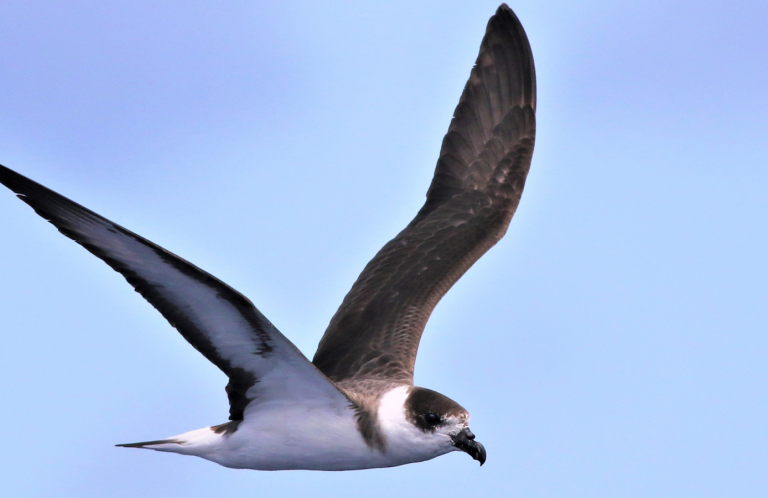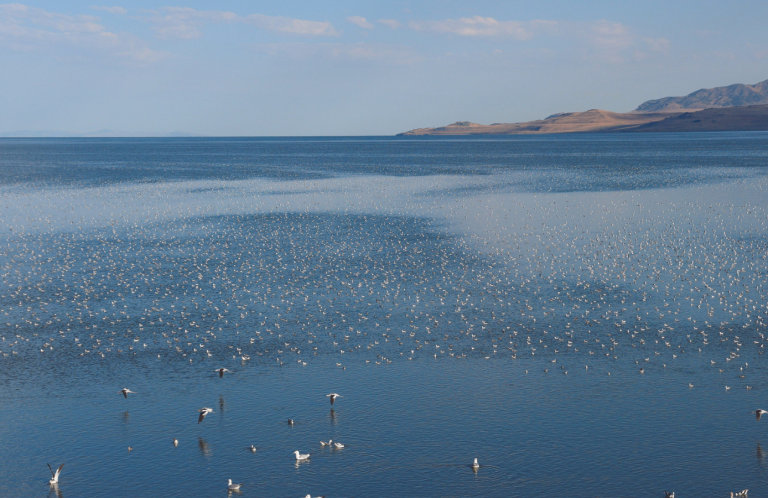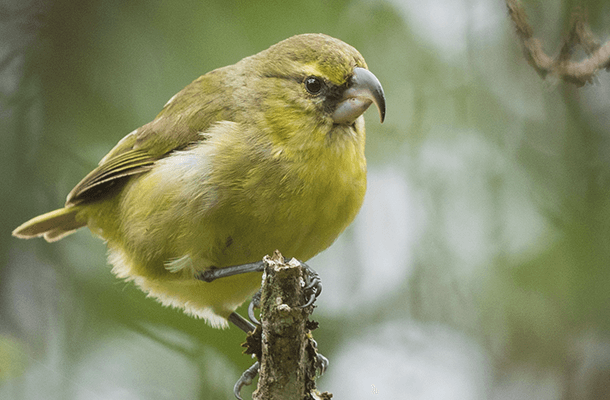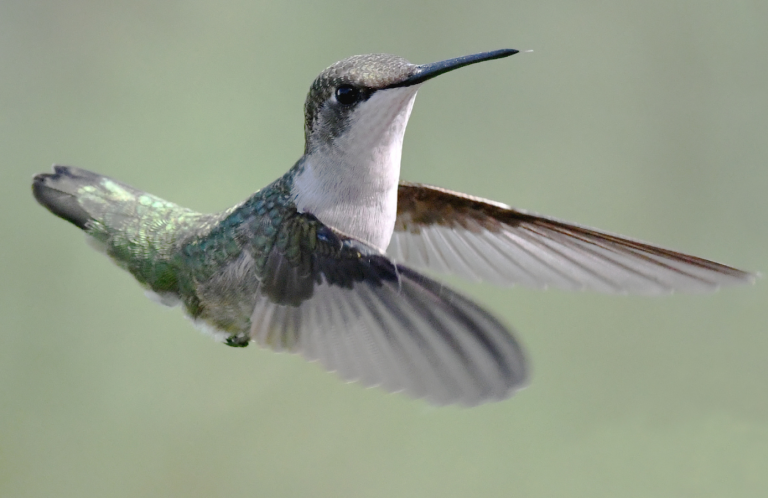Insect Freefall: What Does It Mean for Birds?
Many people quip that they'd prefer a world without “bugs,” but as the adage goes: Be careful what you wish for. Our planet cannot function normally without insects and other invertebrates. “The little things that run the world” is what biodiversity pioneer Edward O. Wilson calls them. Insects anchor natural systems and provide invaluable natural services, as pollinators, scavengers, predators, and protein-packed prey that sustains many birds, fish, amphibians, reptiles, and mammals, in virtually all terrestrial ecosystems.
Yet insect diversity and abundance are plummeting in many places.
This leaves conservationists scrambling to find out why…and wondering what insect declines mean for other wildlife.
“We are seeing declines in abundance, diversity, and biomass of insects,” says Scott Hoffman Black, Executive Director of The Xerces Society for Invertebrate Conservation, “and by extension we have to assume that this is, and will be, impacting birds.”
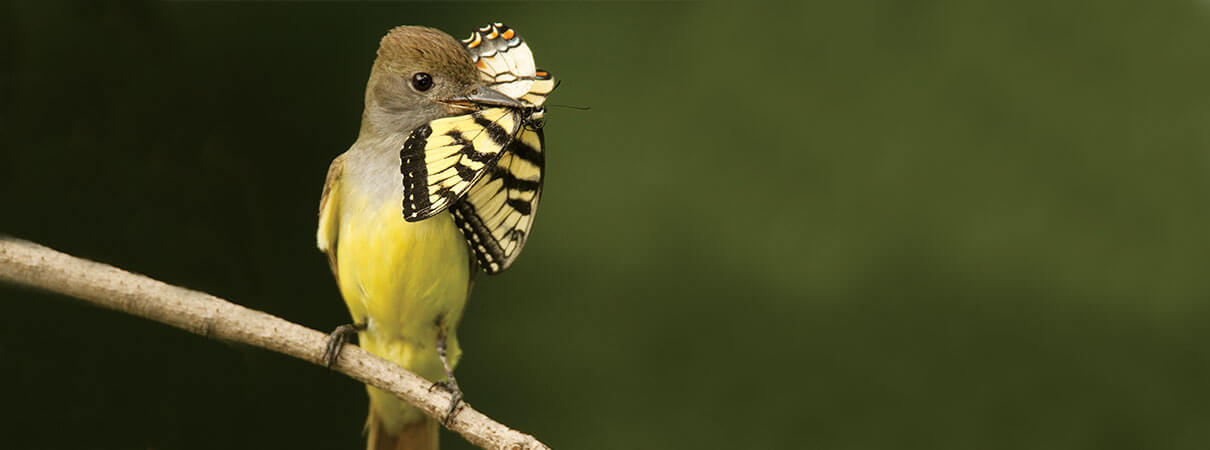
Great Crested Flycatcher. Photo by Joe McDonald/Shutterstock.
The clues in this mystery include large-scale disappearance of insects, dipping bird populations, and a line-up of potential culprits including pesticides, habitat loss, and climate change. What's likely on the horizon is a choice: Do we ignore insect declines to our detriment, or change some of our most destructive day-to-day routines, which seem to be modifying our world into a more sterile place?
Vanishing Insects, Mounting Concern
Although there are not many long-term studies on insects in North America, the studies done have revealed sharp declines in certain species, including Monarch butterflies and Rusty-patched Bumble Bees, and even entire groups. “In Ohio, a study found a 33-percent reduction in abundance of butterflies over 21 years,” says Black, “and a long-term 45-year-long study with transects across California is finding declines at all sites and of all different butterfly groups.”
A study out of Germany has raised even more eyebrows, standing out for its longevity, the many sites monitored, and the focus on sampling all flying insects.
This wide-ranging, long-term investigation, published in the online journal PLOS ONE in 2017, spans 27 years of collections — and shows a more-than-75-percent decline in the flying insect biomass at 63 protected areas. The investigators used Malaise traps, tent-like contraptions that channel flying insects between fine mesh panels to a collection container. Collections made at these traps, basically masses of flying insects of many types, were weighed to gauge biomass for each reserve over different years.
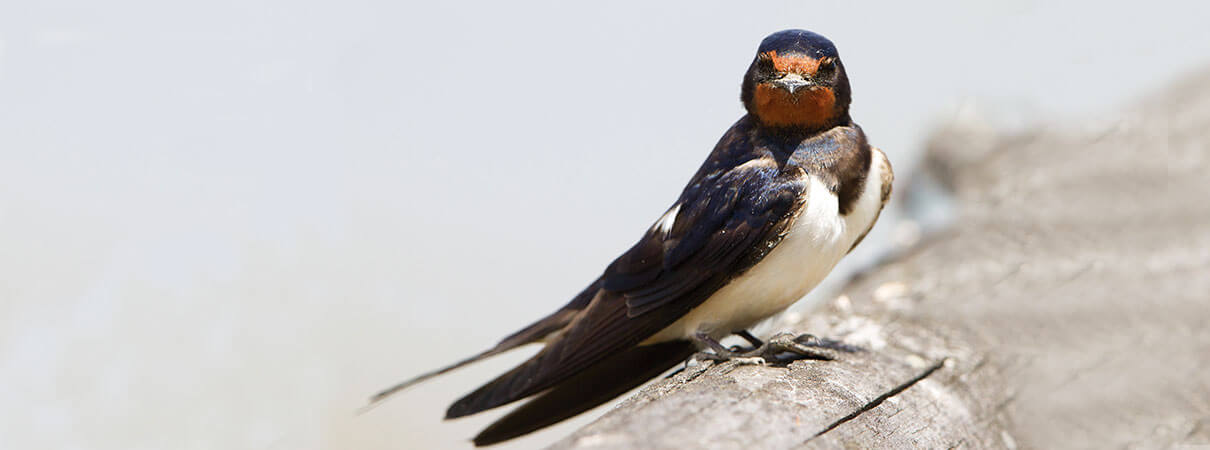
In the Netherlands, rapid declines in Barn Swallows and other insect-eating farmland birds were attributed to a "depletion of the birds' food — insects." Photo by Bildagentur Zoonar GmbH/Shutterstock.
The authors write: “Our results demonstrate that recently reported declines in several taxa such as butterflies, wild bees, and moths, are in parallel with a severe loss of total aerial insect biomass, suggesting that it is not only the vulnerable species, but the flying insect community as a whole, that has been decimated over the last few decades.”
By just looking at collection jars on the shelves, the investigators could see the winnowing of insect populations. Caspar A. Hallmann, an entomologist at Radboud University Nijmegen in the Netherlands and one of the study's authors, says: “In the early 90's, you would fill a jar of one liter in about a week, requiring a more rapid replacement of jars at shorter time intervals…or they would overflow. In recent years, collectors of the Krefeld Entomological Society have used quarter-liter jars, which would not fill even after two weeks of trapping. It is really apparent.”
Silence in the Forest
Dropping insect populations impact many birds. Excepting seabirds, 96 percent of North American bird species feed insects to their young. Caterpillars alone are an important food source for at least 310 North American bird species.
Strictly insectivorous species seem to be particularly hard hit. For example, the Eastern Whip-poor-will's incessant namesake cries no longer permeate woodlands in many parts of its mapped range. After analyzing stable isotope signatures in Eastern Whip-poor-will museum specimens from Ontario, researchers wrote in the journal Frontiers in Ecology and Evolution in 2018: “For aerial insectivores, a significant change in dietary isotopes of whip-poor-wills over the past 130 years adds to the mounting evidence that population declines for many of these species may be related to changes in food supply.”
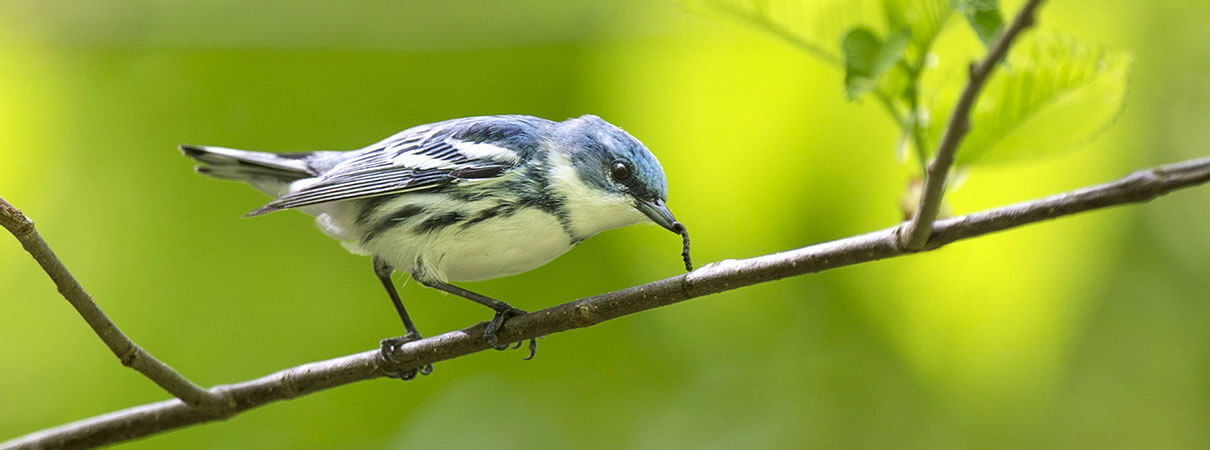
Cerulean Warbler with caterpillar. Photo by Ray Hennessy/Shutterstock.
The researchers suggest that their findings could reflect the harmful effects of a decline in large night-flying moths, beetles, and other insects that left whip-poor-wills feeding at a lower trophic level, or stage in their ecosystem's food chain. The drop in prey size, diversity, and abundance may stifle whip-poor-will reproduction. More study is required to know if whip-poor-wills' and other aerial insectivores' declines are linked to pesticides, habitat loss and degradation, light pollution, or other factors.
Direct consumption aside, insects are critically important to birds in other ways. More than 85 percent of flowering plants require animal pollination; in most cases this job is done by insects. “If you start to lose those pollinators,” says the Xerces Society's Black, “this also impacts many plants, and by extension birds. Many birds, for example, eat small fruits or seeds. A lot of these are from insect-pollinated plants.”
READ MORE: Chickadee Study Highlights Native Plant Benefits
Insects and spiders make up about 90 percent of the Carolina Chickadee's diet during the nesting season, and about 40 percent at other times. Researchers recently found that these nonmigratory songbirds struggled to raise their young in residential yards near and within Washington, D.C., that were packed with exotic landscaping because, due to the nonnative plants' “evolutionary novelty,” they attracted far fewer caterpillars and other insects than did native species. Biologists Desirée Narango, Douglas Tallamy, and Peter Marra wrote: “Our work demonstrates that even a common ‘urban-adapted' bird species is food-limited when nonnative plants dominate landscapes….”
“If we think about it,” says Narango, “landscaping with nonnative plants is one part of this issue of insect declines. We're making our residential areas food deserts full of plants that herbivorous insects can't eat, which means fewer insects…and less food for insectivorous birds.”
Working with homeowners as part of the citizen science program Smithsonian Neighborhood Nestwatch, Narango, Tallamy, and Marra found that areas with less than 70 percent native-plant biomass were a “dead end for insectivorous birds,” where chickadees had “lower reproductive success and unsustainable population growth…,” sometimes foregoing reproduction altogether.
— Howard Youth
A Toxic Shadow
Many scientists believe agricultural alchemy plays a big role in insect declines. Pesticides cast a broad yet invisible shadow over huge swaths of land, often well beyond areas they are meant to treat.
Pesticides and intensive farming loom large as culprits in the stark drop in France's farmland avifauna, where populations of farm-nesting species dipped by, on average, a third over the past 15 years. Partridges, Meadow Pipits, and others suffered far steeper declines in that time.
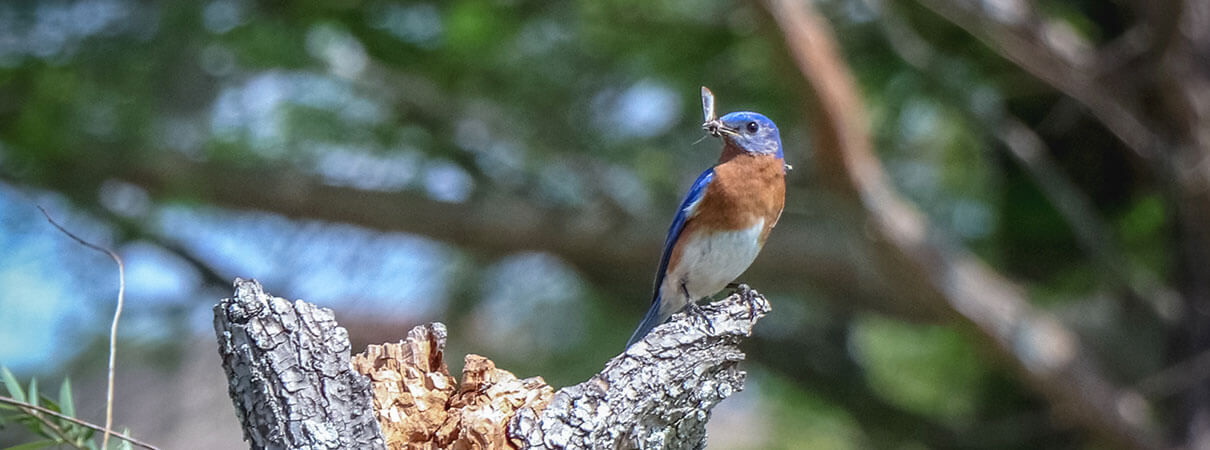
Eastern Bluebird with insect snack. Photo by Benjamin Klinger/Shutterstock.
In recent decades, 24 of 39 farmland bird species have declined in agricultural habitat encompassing 45 percent of the European Union's land. Even generalist species such as the Common Woodpigeon seem to fare better in cities than on farms, and bees as well. Farm pesticides' effects on nontarget species are suspected to be a principal cause.
Today, the world's most widely used agricultural pesticides are neonicotinoids, neurotoxins absorbed and stored in plant tissues so they repel insect pests. Neonics, as they are also known, are now banned in the European Union because of their impact on honeybees. A number of U.S. states have also introduced legislation attempting to prohibit or limit their use.
Persistent and water-soluble, neonics are highly toxic to a broad range of insects and other invertebrates. And they reach well beyond farm fields, leaching into watersheds, rising up in dust, and soaking into soil adjacent to farms, toxifying insect food plants there.
Neonics' impact on nontarget terrestrial and aquatic insects is formidable, and long-lasting as well. Depending upon soil and other factors, neonics have half-lives — the time it takes to reduce an amount of the pesticide by half — of up to 1,000 days, or nearly three years.
Although these insecticides are considered less dangerous to many vertebrates than are other pesticides, an ABC study in 2013 determined that a single neonic-coated seed can kill a bird the size of a Blue Jay.
Proving a direct link between bird declines and pesticides' impact on their insect food is difficult given other factors also at play, including habitat loss, climate change, and the direct physical effects of the chemicals on birds. But a study published in the journal Nature in 2014 was the first to “provide direct evidence that the widespread depletion of insect populations by neonicotinoids has knock-on effects on vertebrates.” In that study, in the Netherlands, rapid declines in Eurasian Skylarks, Barn Swallows, Western Yellow Wagtails, and other insect-eating farmland birds were attributed not to direct effects of the chemicals on the birds, but likely “the result of a depletion of the birds' food — insects.”
Scissor-tailed Flycatcher eating grasshopper. Photo by Brian Lasenby/Shutterstock.
Given their widespread use — for example, most corn-growing acreage in the United States is treated with neonics — these pesticides require much more research, and controls or bans. A recent review of existing research, published in Environmental Science and Pollution Research International, reports: “Correlational studies have suggested a link between neonicotinoid usage in agricultural areas and population metrics for butterflies, bees, and insectivorous birds in three different countries.”
Other potent chemical threats persist. For more than 50 years, the organophosphate chlorpyrifos has been sprayed on apples and other fruits, vegetables, nuts, and other crops. Related to sarin gas, chlorpyrifos is among the most toxic pesticides to reach aquatic ecosystems. It is a threat not only to birds that ingest it, but also to their insect food base.
ABC and other groups are calling for a ban on the use of chlorpyrifos. Environmental Protection Agency (EPA) scientists agreed that there is no way to use the pesticide safely, and the agency was on course to ban it in spring 2017. But EPA reversed course, extending its use for five years. In July, EPA rejected a challenge by a coalition of environmental and public health advocacy groups that urged the agency to ban the pesticide. ABC and others continue to advocate for legislation prohibiting chlorpyrifos' use. Meanwhile, states are taking action: California, Hawai‘i, and New York have initiated bans, and a few other states may soon follow.
This Land Is Your Land, This Land Is Wild Land
Most of the German protected areas covered in the landmark 2017 PLOS ONE study are small holdings surrounded by farmland, leading the investigators to suspect physical and chemical factors at play. “Agricultural intensification, including use of pesticides, is as far as I am concerned one of the prime suspects responsible for the insect decline,” says Hallmann.
Around the world, much of the goliath human footprint on the land comes in the form of cropland agriculture, grazing land, as well as both carefully and haphazardly logged forest. On these working lands, decisions on where habitat is cleared, whether or not it's managed with native plants, and where and how pesticides are applied will have a huge impact on insects and thus the future of birds.
Recent investigations provide a window into how, with more knowledge and the will to coexist, people can both work the land and maintain a higher diversity of insects, birds, and other wildlife. A 2019 PLOS ONE study conducted in Finland, for example, reveals that of all farm types in Europe, organic livestock farming is the only one to significantly boost populations of insectivorous and migratory birds, including swallows. The livestock and their dung draw insects; rotational grazing improves habitat health and plant diversity; and the semi-wild state of chemical-free pastures most closely matches untouched grassland, which is a very rare commodity in Europe these days.
Land use involving at least a partial tree canopy can be very beneficial to insects and birds, if native species are used. A study published this year in the journal Biotropica examined native canopy trees on shade-coffee farms in Nicaragua and Colombia. Researchers found that insectivorous birds favored certain species planted to provide shade for coffee plants, likely because they harbor the highest insect abundance and diversity. These preferred native trees include some in the legume family Fabaceae, such as Guanacaste and Guamo, which also benefit farmers by fixing nitrogen in the soil. Armed with this study's results, farmers can make simple choices that benefit their farms, insects, and birds.
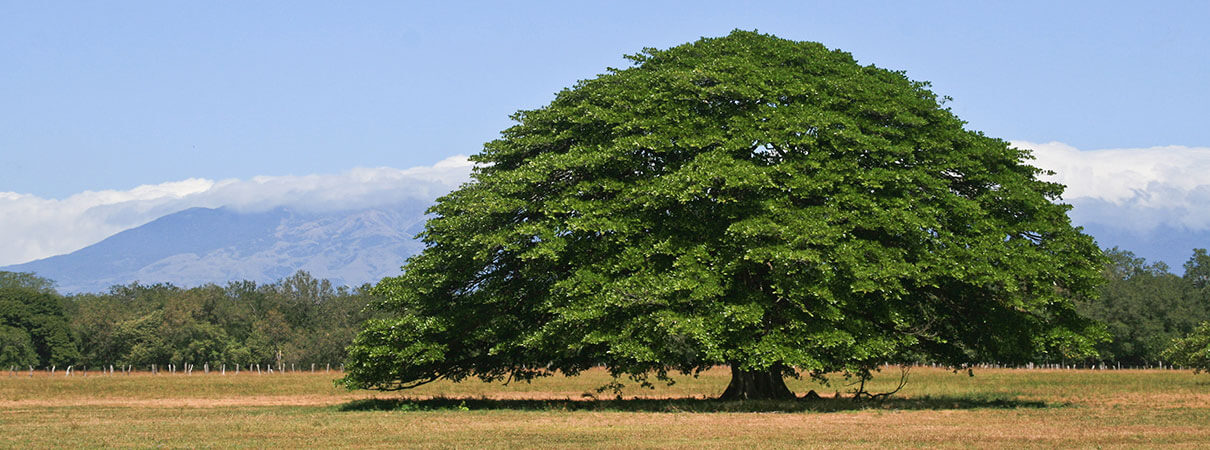
Guanacaste tree. Photo by Raymond Pauly/Shutterstock.
Another recent study, published in the journal Wildlife Biology in January, focused on another native tree, the Andean Alder. In Colombian alder plantations, researchers found more insectivorous birds than in regenerating natural forest of about the same age (35 to 40 years). Comparing insect-eating bird abundance and diversity in both habitats, the team found that fly-catching and foliage-gleaning birds abounded in the alders, where greater sunlight penetration resulted in lush undergrowth supporting an insect bounty. The Black-capped Tyrannulet, Plushcap, and 15 other bird species were found in the alders, but not in nearby secondary forest, although with its greater diversity of trees and tree sizes, that habitat drew tree-trunk foragers not attracted to the alders, including the Powerful Woodpecker and Black-banded Woodcreeper.
In the end, the authors did not consider alder plantations replacements for natural forests, but rather complements to them. The differing habitats and their birds raise interesting questions about “green” land uses that offer significant benefits to insects and birds.
Rainforest in the Hot Seat
Climate change is very likely detrimental to insects and insectivores, including birds. Reported in Proceedings of the National Academy of Sciences in 2018, one study looked at the biomass of arthropods — invertebrates including insects, spiders, and centipedes — in Puerto Rico's largest remaining rainforest, El Luquillo.
The researchers also surveyed populations of insect-eating Anolis lizards, frogs, and birds, comparing what they found with prior survey results from the 1970s. These comparisons were made with a troubling backdrop: Over the 30-plus years between surveys at El Luquillo, the average maximum temperature in the forest there rose 3.6 degrees Fahrenheit.
The study notes a drop in arthropod biomass of between four- and eight-fold since the 1970s, with parallel declines in Anolis lizards, frogs, and birds. This includes a 90-percent drop in mist-net captures of the endemic Puerto Rican Tody — a tiny green, white, and red bird that can snap up about 40 percent of its weight in insects in a day.
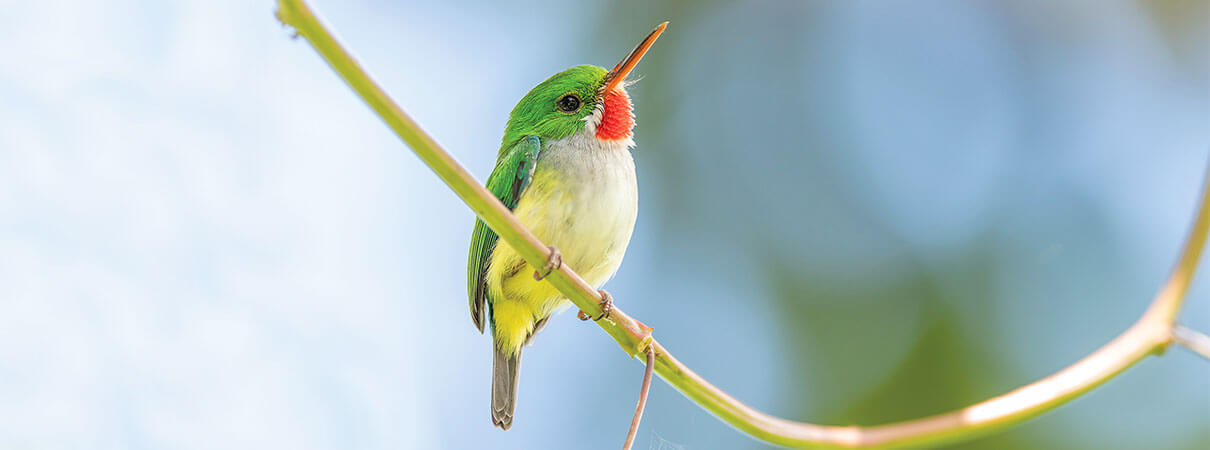
Puerto Rican Tody. Photo by Falko Duesterhoeft/Shutterstock.
More study is required in El Luquillo — which was subsequently hammered by Hurricane Maria in 2017 — and other parts of the tropics, but the study's authors wrote: “Our analyses provide strong support for the hypothesis that climate warming has been a major factor driving reductions in arthropod abundances, and that these declines have in turn precipitated decreases in forest insectivores in a classic bottom-up cascade.” They added that the same scenario is likely playing out in other tropical forests experiencing significant increases in ambient temperature.
No Birds Without “Bugs”
From farm fields to alder plantations to remaining rainforest, conservationists now ponder, with a sense of urgency, human activities' unintended and intentional impacts on insects and birds.
Although many people are just now awakening to the ecological importance of insects, those who valued them all along are rolling up their sleeves to learn more and do more to conserve them.
“The authors of the German study were very fortunate to have started data collection decades ago,” says the Xerces Society's Black. “This study has got many other researchers thinking about implementing long-term monitoring.” But Black and others say that while further studies are important, so is immediate action to stem the loss of diversity and abundance of insects and other wildlife.
Exactly what insect declines mean for birds, and for us, is an emerging picture, but the todies, skylarks, and whip-poor-wills seem to tell us something we may have taken for granted before: There can't be birds without “bugs.”
 | Howard Youth is ABC's Senior Writer/Editor, and is the author of Field Guide to the Natural World of Washington, D.C. |





































